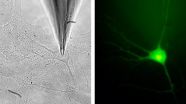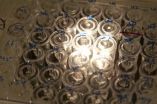(Press-News.org) Neurons communicate via chemical transmitters which they store in the bubble-like synaptic vesicles and release as required. To be able to react reliably to stimulation, neurons must have a certain number of "acutely releasable" vesicles. With the help of a new method, neuroscientists at the Max Planck Institute of Experimental Medicine in Göttingen have now discovered that neurons systematically recycle the protein components necessary for transmitter release and in this way guarantee the reliability of signal transmission in the brain. If this process is disrupted, the communication between the neurons quickly comes to a standstill and vital processes that rely on the rapid transmission of information, for example seeing or the instant identification of a sound source, become impossible to carry out. (Neuron, November 4, 2010)
Neurons transmit signals to each other via specialised contacts known as synapses. When a transmitting neuron is excited, it releases chemical transmitters that are discharged by tiny membrane-enclosed vesicles and then reach the recipient cell. The release of the transmitters is carried out through the fusion of the vesicles with the cell membrane - a process that requires the interaction of different protein components in the cell.
Before the transmitter vesicles can fuse with the neuronal membrane they must first be transformed into an active state. The corresponding biochemical process is referred to as priming. During this process, a structure known as a SNARE complex is constructed from protein components that are required for the rapid fusion of the vesicles with the cell membrane.
Headed by the Korean neuroscientist JeongSeop Rhee, a group of researchers from the Max Planck Institute of Experimental Medicine in Göttingen have now developed a new method that can be used for the direct measurement of synaptic vesicle priming. The scientists made use of a method that, before now, could only be used for a few special cell types. "Instead of stimulating the neurons electrically, using our measuring system we fill them with a chemically packed signal – containing calcium ions – and then destroy the packaging with a flash of ultraviolet light," explains Rhee. This enabled the scientists to get around many of the complicated processes that normally precede vesicle fusion. They made the process possible by cultivating neurons in Petri dishes on minute islands of just 0.04 square millimetres in size.
With his new method, Rhee and his colleagues Andrea Burgalossi and Sangyong Jung discovered that two protein components, known as SNAPs, play an extremely important role in the recycling of SNARE complexes at synapses. Without SNAPs the recovery of the individual components of SNARE complexes is blocked, and the synapse function also blocked in time.
"We are particularly fascinated by our new method," says JeongSeop Rhee, "because it provides previously unavailable insights into the mechanisms of transmitter release from synapses." The new information about the priming role of the SNAP proteins is also very important. "A number of pharmaceutical companies are working on processes to influence the priming of synaptic vesicles." If the researchers succeed in regulating this process pharmacologically, it would be possible to develop completely new epilepsy treatments that would avoid many of the side affects associated with the current treatment process.
INFORMATION:
Original work:
Burgalossi, A., Jung, S., Meyer, G., Jockusch, W.J., Jahn, O., Taschenberger, H., O'Connor, V.M., Nishiki, T., Takahashi, M., Brose, N. und Rhee, J.-S.
SNARE protein recycling by alpha SNAP and beta SNAP supports synaptic vesicle priming.
Neuron, November 4, 2010
Synapses recycle proteins for the release of neurotransmitters
2010-11-11
ELSE PRESS RELEASES FROM THIS DATE:
Portrait of gambling behavior in Quebec
2010-11-11
Montreal, November 10, 2010 – The initial findings of a survey on the prevalence of gambling in Quebec have been released. The study also deals with behavior problems associated with gambling. The study reveals that nearly 70 percent of Quebec adults report having bet or spent money on gambling during the previous 12 months. It also found Quebecers spend an average of $483 annually on gambling activities.
This survey was conducted between June and September 2009 throughout the province among 11,888 non-institutionalized adults over the age of 18. It constitutes the first ...
Army-funded technology detects bacteria in water
2010-11-11
November 10, 2010 -- To keep soldiers in the battlefield healthy, the U.S. Army is exploring new ways to detect harmful bacteria in water.
Current techniques for analyzing water in the field can take as long as 24 hours to complete, according to Bart Lipkens of Western New England College in Springfield, Massachusetts and his colleagues at Physical Sciences in Andover, Ma.
They are working on an alternative technology that uses sound waves to accelerate the process.
"The goal of our project is to speed up the detection of bacteria in water supplies," said Lipkens. ...
Evolutionary bestseller in image processing
2010-11-11
The eye is not just a lens that takes pictures and converts them into electrical signals. As with all vertebrates, nerve cells in the human eye separate an image into different image channels once it has been projected onto the retina. This pre-sorted information is then transmitted to the brain as parallel image sequences. Scientists from the Max Planck Institute of Neurobiology in Martinsried have now discovered that fruit flies process optical information in a similar way. The evidence suggests that this type of wiring is an effective energy-saving mechanism and is therefore ...
Out-sniffing bomb-sniffing dogs
2010-11-11
Dogs have long been called man's best bomb detector –– until now.
A Tel Aviv University scientist leads a research team that has developed a powerful electronic sensor to detect multiple kinds of explosives –– including those used in the recent Yemeni bomb threat. Based on nanotechnology advances, the new sensor is small, portable, and is more sensitive and reliable at detecting explosives than any sniffer dog, says its lead researcher Prof. Fernando Patolsky of Tel Aviv University's Raymond and Beverly Sackler School of Chemistry.
With scientific findings on it published ...
GM, Chrysler bankruptcies created troubling legacy, legal scholars say
2010-11-11
CHAMPAIGN, Ill. — The Chrysler and General Motors bankruptcy reorganizations represented a sea change in corporate restructuring, one that could portend the end of our current system of bankruptcy reorganization, according to a published article by two University of Illinois experts in bankruptcy law.
Law professors Charles J. Tabb and Ralph Brubaker argue that the legal principles applied in the GM and Chrysler bankruptcies – two of the largest in U.S. history at $83.5 and $39.9 billion, respectively – were misguided, and ultimately have undermined the distributional ...
'Toxic toy crisis' requires fresh solutions
2010-11-11
Manufacturer recalls of toys, promotional drinking glasses, and other children's products constitute an ongoing "toxic toys crisis" that requires banning potentially harmful ingredients in these products and other changes in policy and practices. That's the conclusion of a new analysis in ACS' Environmental Science & Technology, a semi-monthly journal.
Monica Becker, Sally Edwards and Rachel Massey note that in June the United States government recalled 12 million promotional drinking glasses sold at a fast-food restaurant chain because the painted coating contained ...
Seeing the invisible: New CSI tool visualizes bloodstains and other substances
2010-11-11
Snap an image of friends in front of a window curtain and the camera captures the people - and invisible blood stains splattered on the curtain during a murder. Sound unlikely? Chemists from the University of South Carolina are reporting development of a camera with that ability to see the invisible, and more. Called multimode imaging in the thermal infrared, the new technology could find uses in crime scene investigations and elsewhere, they say in a series of three reports in ACS' Analytical Chemistry, a semi-monthly journal.
Michael Myrick, Stephen Morgan and their ...
DNA repair protein caught in act of molecular theft
2010-11-11
Scientists have observed, for the first time, an intermediate stage in the chemical process that repairs DNA methylation damage and regulates many important biological functions that impact health conditions such as obesity, cancer and diabetes.
The observations focused on the bacterial DNA repair protein AlkB, but the results also apply to several proteins in the same family that play key regulatory roles in humans. Armed with these results, researchers may one day develop methods for blocking the protein's efforts to perform the biologically important demethylation ...
Trojan Horse ploy to sneak protective drug into brains of stroke patients
2010-11-11
Scientists are reporting development of a long-sought method with the potential for getting medication through a biological barrier that surrounds the brain, where it may limit the brain damage caused by stroke. Their approach for sneaking the nerve-protective drug erythropoietin into the brain is medicine's version of the Trojan Horse ploy straight out of ancient Greek legend. It also could help people with traumatic head injuries, Parkinson's disease, and other chronic brain disorders. Their report appears in ACS' Molecular Pharmaceutics, a bi-monthly journal.
William ...
Soft drink could enhance effects of an anticancer drug
2010-11-11
Experiments with an artificial stomach suggest that a popular lemon-lime soft drink could play an unexpected role in improving the effectiveness of an oral anticancer drug. The experiments produced evidence that patients will absorb more of the unnamed drug, tested in Phase I in clinical trials, when taken with "flat" or degassed Sprite. The study appears in ACS' Molecular Pharmaceutics, a bi-monthly journal.
Faraj Atassi and colleagues note that efforts are underway to develop more anticancer medications that patients can take by mouth. However, biological variations ...




